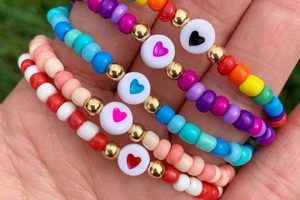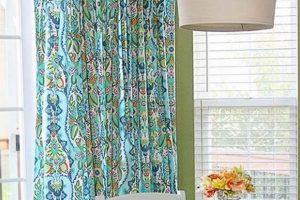Headliner replacement and refurbishment present opportunities for vehicle owners to personalize their automobiles while potentially saving on professional service costs. These projects encompass a variety of techniques and material selections aimed at restoring or improving the interior roof lining of a car. Considerations within this realm include fabric choice, adhesive types, and methods for securing the new material to the headliner board.
Undertaking headliner repair independently can offer significant cost savings compared to professional upholstery services. Furthermore, it provides the ability to customize the vehicle’s interior aesthetic to individual preferences, reflecting unique style and design sensibilities. Historically, these tasks were often performed by specialized automotive trimmers, but accessible materials and online resources have broadened participation in this practice.
The subsequent sections will explore specific approaches to achieving a successful outcome. This involves examining material selection criteria, detailing the necessary tools and preparation steps, and presenting various methods for applying and securing the headliner fabric. Common challenges and troubleshooting tips will also be addressed.
Headliner Refurbishment Strategies
Achieving a successful outcome in headliner restoration or replacement requires meticulous planning and execution. The following strategies provide guidance for ensuring a durable and aesthetically pleasing result.
Tip 1: Fabric Selection: Prioritize headliner-specific fabrics, considering factors such as weight, durability, and resistance to sagging. Ensure the chosen material complements the vehicle’s interior and resists fading from prolonged sun exposure.
Tip 2: Adhesive Application: Employ a high-temperature adhesive designed for automotive interiors. Apply adhesive in thin, even coats to both the headliner board and the fabric, allowing appropriate tack time before bonding. Uneven application can lead to bubbling or premature failure.
Tip 3: Board Preparation: Thoroughly clean and prepare the headliner board by removing all traces of old adhesive and deteriorated foam. Address any structural damage to the board before applying the new fabric. Damage left unaddressed will cause the new headliner to fail prematurely.
Tip 4: Stretching and Alignment: When applying the fabric, maintain consistent tension to avoid wrinkles or creases. Begin at the center of the board and work outwards, carefully aligning the fabric to ensure a smooth, even finish. Small adjustments during the application process will ensure a quality finish.
Tip 5: Trimming and Finishing: Use sharp cutting tools to precisely trim excess fabric around the edges of the headliner board. Secure the edges with appropriate trim pieces or adhesive to prevent fraying or detachment. A clean, professional trim adds to the longevity and visual appeal.
Tip 6: Ventilation and Curing: Ensure adequate ventilation during the adhesive application and curing process. Allow sufficient time for the adhesive to fully cure before reinstalling the headliner in the vehicle. Inadequate ventilation can lead to health issues while poor curing will result in headliner failure.
Successful headliner refurbishment relies on careful material selection, precise application techniques, and thorough preparation. Adhering to these strategies will yield a professional and durable result.
The subsequent section will address common challenges encountered during headliner projects and provide solutions for overcoming these obstacles.
1. Material Selection
The success of automotive headliner restoration is intrinsically linked to appropriate material selection. The chosen fabric directly influences the finished product’s durability, aesthetic appeal, and resistance to environmental factors. Inappropriate fabric selection can lead to premature sagging, discoloration, or adhesive failure, thereby undermining the entire endeavor. For example, using a non-automotive grade fabric lacking UV resistance will invariably result in fading and degradation when exposed to prolonged sunlight, negating any cost savings initially realized.
Automotive headliner fabrics are specifically engineered to withstand high temperatures, resist stretching, and provide a suitable surface for adhesive bonding. Utilizing these materials ensures compatibility with automotive adhesives and provides a stable platform that minimizes the risk of delamination. Furthermore, the weight and texture of the chosen fabric impact the ease of application and the overall finish. A heavier, thicker fabric may require more adhesive and greater skill to stretch and conform to the headliner board’s contours, while a poorly textured fabric might exhibit imperfections more readily.
Therefore, material selection transcends mere aesthetic preference; it constitutes a foundational element for achieving a professional-grade result. Choosing a fabric specifically designed for automotive headliners, considering factors such as UV resistance, weight, and texture, provides the necessary framework for a durable and visually appealing repair. While alternative materials may seem viable initially, the long-term performance and aesthetic integrity of the headliner are contingent upon selecting a fabric formulated for this specific application.
2. Adhesive Quality
The adhesive employed in a headliner project directly influences the longevity and structural integrity of the repair. Inadequate adhesive selection precipitates premature headliner failure, characterized by fabric detachment and sagging. The automotive environment presents unique challenges, including elevated temperatures and constant vibration, necessitating the use of adhesives specifically formulated to withstand these conditions. For instance, a general-purpose adhesive lacking high-temperature resistance will soften and fail, especially during prolonged exposure to direct sunlight, rendering the entire effort ineffective. The bond strength and heat resistance properties of the adhesive are, therefore, paramount considerations.
Proper adhesive application techniques are equally crucial. Uniform coverage, coupled with adherence to recommended drying times, ensures optimal bond formation. Insufficient adhesive coverage creates weak points susceptible to separation. Conversely, excessive adhesive application can saturate the fabric, leading to visible staining or uneven texture. The selection of an appropriate application method, such as spraying or brushing, should align with the adhesive’s properties and the fabric’s composition. The objective is to achieve a consistent and durable bond that resists degradation over time, maintaining the headliner’s structural integrity.
Ultimately, the effectiveness of a do-it-yourself headliner restoration hinges significa
ntly on the adhesive’s quality and its proper application. Investing in a high-grade, automotive-specific adhesive and diligently following recommended procedures mitigates the risk of premature failure. Compromising on adhesive quality, even with meticulous board preparation and fabric installation, inevitably leads to unsatisfactory results, negating the time and resources invested in the project. Therefore, adhesive selection is a critical decision point with long-term implications for the headliner’s performance and overall appearance.
3. Board Preparation
Board preparation represents a foundational stage in any successful headliner replacement or restoration undertaking. The original headliner board, typically constructed of fiberboard or a similar composite material, often retains remnants of the previous adhesive, deteriorated foam, and accumulated debris. Failure to adequately remove these contaminants compromises the adhesion of the new fabric, leading to premature sagging and detachment. For instance, residual foam particles create an uneven surface, preventing uniform contact between the fabric and the board, resulting in localized areas of adhesive failure. The degree of board preparation directly correlates with the longevity and aesthetic quality of the finished headliner.
The process of board preparation involves a meticulous cleaning and smoothing procedure. This often necessitates the use of specialized tools such as wire brushes, scrapers, and sandpaper to eliminate all traces of the old adhesive and foam backing. Any structural damage to the board, such as cracks or warpage, must also be addressed before applying the new headliner material. Minor cracks can be repaired with fiberglass resin or epoxy, while severely warped boards may require replacement. Neglecting these repairs can result in an uneven or unstable surface, detracting from the overall appearance and increasing the likelihood of future failures. A clean, smooth, and structurally sound board is essential for creating a stable substrate for the new headliner fabric.
In summary, thorough board preparation is not merely a preliminary step but an integral component of achieving a durable and professional-looking headliner. By diligently removing contaminants, repairing structural damage, and ensuring a smooth, even surface, the foundation is laid for a successful headliner installation. The time and effort invested in proper board preparation ultimately translate into a longer-lasting, more aesthetically pleasing result, underscoring its importance in any headliner refurbishment project. Challenges may arise from stubborn adhesive residue or extensive board damage, but prioritizing this phase ensures a superior outcome.
4. Fabric Tension
Fabric tension represents a critical parameter in the realm of do-it-yourself headliner projects. Its precise management dictates the final aesthetic quality, structural integrity, and long-term durability of the headliner assembly. Improper tension can manifest in various undesirable outcomes, including wrinkles, sagging, and premature adhesive failure. Therefore, a comprehensive understanding of tension-related variables is paramount for a successful outcome.
- Uniformity of Stretch
Maintaining consistent fabric tension across the headliner board is essential. Uneven stretching leads to localized stress points, resulting in wrinkles and distortions. This uniformity is achieved through a systematic approach, typically involving starting at the center and working outward, incrementally securing the fabric. An example of this is when one section is pulled tighter than another, resulting in visible waves or bunching of the material. This lack of uniformity not only detracts from the visual appeal but can also compromise the adhesive bond.
- Adhesive Bond Integrity
Appropriate fabric tension facilitates optimal contact between the fabric and the adhesive layer on the headliner board. Insufficient tension creates gaps and air pockets, diminishing the adhesive’s bonding strength. Conversely, excessive tension can overstress the adhesive, leading to premature delamination. The correct tension level ensures intimate contact between the surfaces, maximizing the adhesive’s effectiveness and promoting long-term adhesion. This is important as temperature fluctuations in a car could weaken an already poorly bonded headliner
- Contour Conformity
Headliner boards often possess complex curves and contours. Proper fabric tension enables the material to conform seamlessly to these shapes, preserving the intended design. Inadequate tension results in bridging or tenting across recessed areas, distorting the original contours. For example, areas around dome lights or sun visors can be challenging; consistent tension ensures the fabric hugs these features without creating unsightly gaps or distortions. Poor conformity in these areas can indicate a problem with the technique.
- Material Resilience
The inherent elasticity of the chosen fabric also influences the tensioning process. Fabrics with minimal stretch require meticulous attention to avoid over-tensioning, which can lead to tearing or distortion. Conversely, highly elastic materials necessitate careful control to prevent excessive sagging over time. The selected fabric’s properties must be considered when determining the appropriate level of tension. Choosing a material that requires very specific tensioning that is not easy to maintain can negatively affect the overall outcome of the project.
In conclusion, the strategic management of fabric tension is integral to achieving a professional-grade finish in headliner restoration projects. Uniform stretch, robust adhesive bonding, accurate contour conformity, and considerations of material resilience coalesce to determine the headliner’s ultimate appearance and longevity. Mastering the art of tensioning the fabric during installation is thus essential for individuals embarking on these endeavors. For example, a high degree of precision in the hands of someone restoring a vintage car headliner is the difference between a showroom restoration and a poor attempt.
5. Proper Trimming
Proper trimming constitutes a critical final stage in the execution of headliner restoration or replacement. The accuracy and precision of this step directly influence the aesthetic outcome and the overall functionality of the headliner assembly. Inadequate trimming results in several potential issues, including fabric fraying, interference with vehicle components, and an unprofessional appearance. For example, excess material obstructing the installation of sun visors or dome lights not only impairs their operation but also detracts from the finished aesthetic. The ramifications of improper trimming extend beyond mere visual imperfections; they can compromise the integrity of the entire project.
Achieving accurate trimming requires specialized tools and techniques. Sharp cutting instruments, such as utility knives or specialized trimming tools, are essential for creating clean, precise edges. A meticulous approach is crucial, involving careful measurement and marking of the fabric before cutting. Further
more, the edges of the trimmed fabric must be properly secured to prevent fraying or detachment over time. This can be achieved through the use of adhesive, trim pieces, or a combination of both. Consider the instance of securing the headliner material around the perimeter of a sunroof opening. The edge must be trimmed precisely to fit the opening, and then secured with a specialized trim piece to prevent the fabric from unraveling. If the edges are not properly secured, it might cause material sag around the edges of the roof, creating visual eyesore.
In summary, the importance of proper trimming in headliner projects cannot be overstated. It serves as the concluding touch that determines the aesthetic appeal and functional integrity of the final product. Challenges may arise from complex contours or intricate vehicle designs, but prioritizing precision and employing appropriate techniques ensures a professional and durable result. This final step solidifies all preceding efforts, contributing significantly to the overall success and value of the undertaken task.
Frequently Asked Questions
This section addresses common inquiries regarding do-it-yourself headliner replacement and restoration. The information provided aims to clarify best practices and potential challenges associated with these projects.
Question 1: What constitutes a suitable fabric for headliner replacement?
Optimal fabric choices include materials specifically designed for automotive headliners. These fabrics exhibit resistance to UV degradation, high temperatures, and stretching. Considerations should be given to the fabric’s weight, texture, and color to ensure compatibility with the vehicle’s interior.
Question 2: Is specialized adhesive necessary for headliner installation?
Yes. General-purpose adhesives often lack the heat resistance and bonding strength required for automotive applications. High-temperature spray adhesives formulated for automotive interiors are recommended to withstand the extreme temperature fluctuations within a vehicle cabin.
Question 3: What is the correct procedure for preparing the headliner board?
The headliner board must be thoroughly cleaned to remove all traces of old adhesive, foam, and debris. A wire brush or scraper can be employed to remove loose material, followed by a solvent-based cleaner to prepare the surface for new adhesive application. Any structural damage to the board should be addressed before proceeding.
Question 4: How can wrinkles and sagging be avoided during headliner installation?
Consistent fabric tension is crucial. Applying the fabric in small increments, starting from the center and working outward, helps to maintain uniform tension. Heat guns can be cautiously used to soften the fabric and facilitate stretching around complex contours.
Question 5: What tools are essential for a do-it-yourself headliner project?
Essential tools include a utility knife with sharp blades, wire brush, scraper, sandpaper, high-temperature spray adhesive, fabric scissors, measuring tape, and potentially a heat gun. Protective eyewear and gloves are also recommended.
Question 6: What steps should be taken to ensure a professional-looking finish?
Achieving a professional finish requires patience, attention to detail, and the use of high-quality materials. Careful trimming, secure edge finishing, and meticulous adherence to adhesive application instructions are critical components.
Successful headliner refurbishment relies on informed decision-making and precise execution. Adhering to established best practices can significantly enhance the likelihood of a satisfactory outcome.
The subsequent section will provide a concluding summary of the key principles discussed within this guide.
Concluding Remarks
This exploration of “diy headliner ideas” has underscored the multifaceted nature of automotive headliner restoration. Factors such as meticulous material selection, proper adhesive application, thorough board preparation, precise fabric tension, and careful trimming have been presented as crucial determinants of project success. Emphasis has been placed on the importance of informed decision-making and diligent execution to achieve durable and aesthetically pleasing results.
Given the information provided, prospective practitioners can now approach headliner refurbishment with a heightened understanding of the inherent challenges and potential rewards. The quality and longevity of the repair ultimately depend on the commitment to best practices and the utilization of appropriate techniques. The onus rests on the individual to translate this knowledge into practical application, thereby ensuring a positive outcome and extending the lifespan of the vehicle’s interior.







